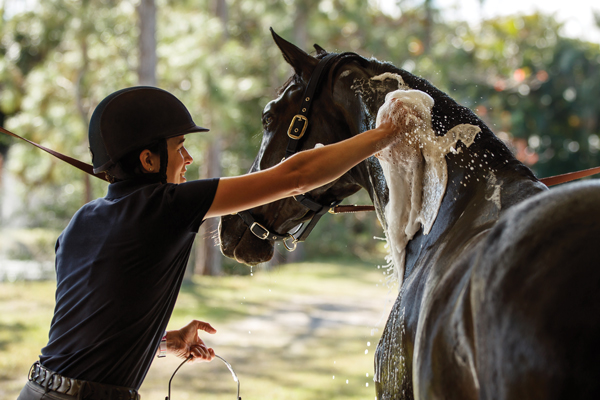
With show season right around the corner, it’s time for a head-to-hoof makeover for your equine partner. Even if you just plan to hit the trails, you’ll enjoy brushing off the last of the winter hair and making your horse look neat and tidy for all those summer selfies. For expert advice on grooming, we turned to Emma Ford, Andis Grooming Educator and a professional who has groomed at the world’s top eventing, show jumping and dressage competitions.

The Mane Event
If you need to pull the mane, Ford recommends this be your first order of business and definitely before washing the horse. “Doing a makeover in a day, I would deal with the mane first before bathing,” she says. “You don’t have to wait for it to dry, and it’s easier to pull a dirty mane than a clean one.”
Ford also advises against wetting or using conditioner on the mane until you get it to the length you want. If you pull a wet mane, it will end up too short because the hair stretches when wet. “Mane length is completely individual, depending on what you’re doing with your horse,” says Ford.
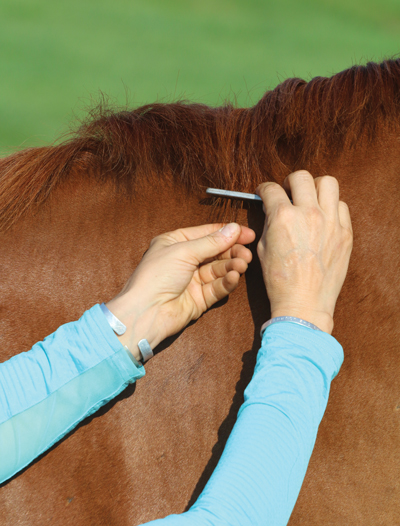
As with tails, this is discipline-oriented, or if you’re not showing, you can shorten to your personal preference. When pulling the mane to make it shorter, she finds four fingers—held horizontally against the crest of the neck—is a good manageable length if you’re going to be braiding the mane.
For horses with very thin manes, you don’t need to pull. In these cases, Ford will use a clipper blade to razor the mane, which yields a finished look without pulling.
Squeaky Clean
Depending on where you live, your horse may already be sleek-coated, or he may need help getting rid of lingering winter hair. Either way, a deep-cleaning bath is in order once you’ve dealt with the mane.
But first, start with a thorough currying.
“If your horse still has a long coat, you’ll really need to dig in with the curry, not just go over the surface,” says Ford. “As you curry, feel for anything that might be missed by observation, such as bumps or ticks. Check the ‘nooks and crannies,’ like the backs of elbows, fetlocks and through the mane.”
Once you’ve removed dust, loose hair and any dried mud, it’s bath time. Wet the coat and skin thoroughly and use a mitt or curry comb to rub in the shampoo. Apply it directly to the mane and tail, using your fingers to work up a good lather. Pay special attention to the dock of the tail, making sure to lift up the dirt that may be caked there.
“I like a shampoo with natural ingredients to avoid drying out the coat with chemicals, which can lead to dry, sensitive skin and skin issues over the long term,” says Ford.
Some people use a bucket to wash the tail, but Ford finds a hose does a fine job. After scrubbing from head to tail, rinse the entire horse until the water runs clean. You’ll know you’re done when you see zero suds.
Moisturize and Condition
Now that you have a clean, wet horse, run a scraper over the body to remove excess water, and then apply a natural coat moisturizer. Depending on how healthy the coat looks, you may prefer a rinse-out formula or a leave-in moisturizer, especially if the coat seems dull or dry.
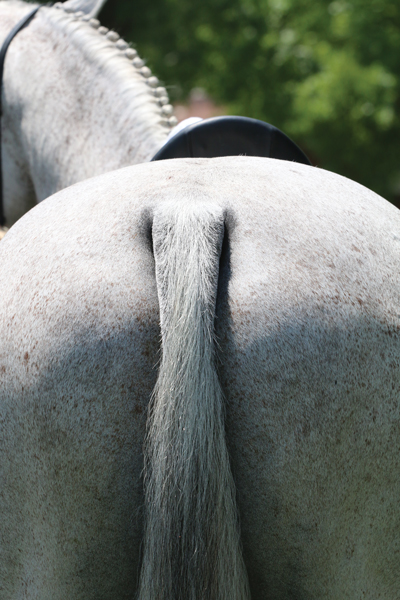
Without worrying about tangles, apply a good conditioner to both mane and tail, leaving it on long enough to really soak in. Ford finds you may need to use more than the label says to get it worked in deeply.
After rinsing, comb the mane over so it lies on the correct side. If you aren’t showing, just let it lie on the side to which it naturally tends to fall.
“If the horse has a wild mane and you’re looking to train it, you can band it down for a few hours to keep it all on the correct side while it’s drying,” says Ford.
“If a horse has a dry tail, I will apply conditioner, then wrap the tail in plastic wrap or a plastic bag held in place with a tail bandage so it will really heat up and condition for about 30 minutes,” she adds.
Finishing Off the Tail
Before rinsing out the conditioner, use your fingers to work out tangles, as this prevents breakage. If you discover a “dreadlock” in the tail, you’ll have to apply more conditioner, but be patient so you don’t pull out hair.
“I use fingers only until the tail is completely conditioned and detangled,” says Ford. “Once it’s dry, I don’t have a problem with using a comb or brush on the tail, so long as you use the right technique, which is bottom to top.”
There are three basic tail choices:
◆ Leave it natural
◆ “Bang” it (blunt cut across the bottom)
◆ Clip or pull the top
Be sure to stay discipline-oriented when finishing off the tail. For example, hunters will braid the tail, so it should be left natural. Eventers and some dressage riders will pull or clip the top of the tail for a neat appearance that accentuates the hindquarters.
Face and Head
After your horse is totally dry, use clippers or scissors to neaten up the appearance of his head and face.
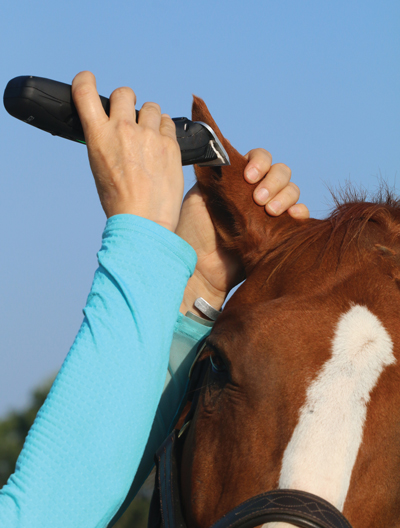
Ford recommends clipping the bridle path behind the ears only as long as the width of the bridle that will rest there, and no longer than two fingers wide. If your horse has a thin forelock, you may want to consider putting some of the mane in with the forelock and only cutting a very small bridle path.
“When it comes to trimming ears, you really have to think about what your horse is doing,” says Ford. “If he’s living outdoors 24/7, he needs some natural defense [against bugs]. I’m not a proponent of totally cleaning out ears with the clippers, but just tidying them up by trimming so there’s a sharp, tidy edge with no wispy bits coming out.”
Finally, trim under the jaw line in the direction of hair growth to take off any long “goat hairs” poking down.
Fetlocks
It’s routine to neatly trim the fetlock “feathers” if you’re showing, but if your horse spends little to no time in a stall, you should probably go easy with the trimming.
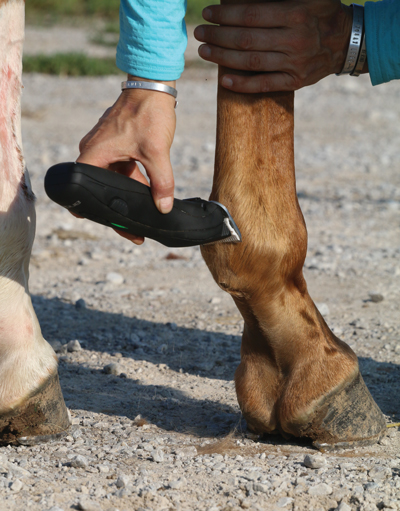
“Feathers are a natural way to keep water off the back of the pastern, so you don’t want to totally remove them if your horse lives outdoors,” says Ford. “One way to avoid some skin problems is to leave the feathers, as this lets water [and rain] drip off, rather than collect on the pastern.”
Ford uses two simple methods to trim fetlocks.
◆ If your horse is good with clippers, use a No. 10 blade and clip down the back of the leg, following the shape of the fetlock and pastern to remove any long hairs. This way, you’re tidying up but not clipping the hair close.
◆ If your horse isn’t fond of clippers, take a wide-tooth comb and brush it up through the feathers. Using scissors, just snip along the teeth of the comb and only cut the hairs that poke out.
Coronary Band and Hooves
Of course, there’s no season where you should not be maintaining a regular schedule with your farrier, so even if your horse’s body looks wild and woolly when you start his makeover, his hooves should be in good shape.
That said, you can make them look extra tidy by trimming up any long hairs extending from the coronary (coronet) band down over the top of the hooves. This can be done with scissors or clippers.
◆ With a steady hand, use scissors to trim just around the coronary band.
◆ Or, using clippers with a No. 10 blade, hold them above the hoof and use a light “scooping” motion upward to clip any hairs extending below the coronary band over the top of the hoof.
Keep It Up
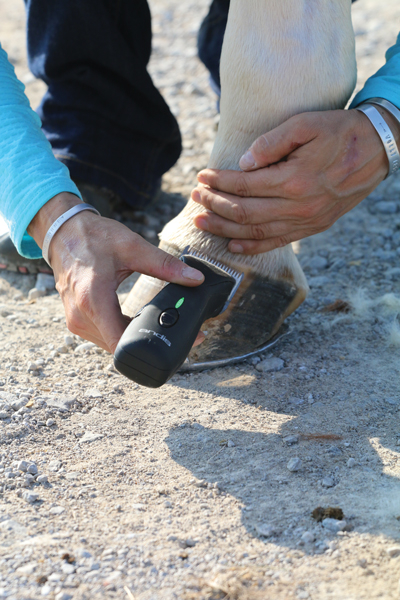
Once your horse is all spiffed up and present-able, you can maintain his makeover with a daily routine—the key word being daily.
“The number one thing is that daily grooming and currying is very important to lift up dirt,” says Emma Ford. “If you need to hose off your horse because it’s hot, that’s fine, but don’t shampoo daily. However, I do believe in shampooing tails as needed. You should also condition and moisturize tails weekly with the product you used earlier, because dry, brittle hair will break, especially when flies are at their peak and horses are using their tails to swat at them.”
Emma Ford recommends finger-grooming tails daily, and finds if you do this, then you’ll only need a detangler product on occasion.
“To ensure the mane stays on the correct side, comb it over when wet. If you’re just groom-ing (not hosing off the horse), you can use some form of hair product, such as beeswax or mousse, to help train it over,” says Ford, who sticks to a simple rule when choosing products: “If you wouldn’t use it on yourself, don’t use it on your horse.”
To maintain the neat-and-tidy look, you’ll want to trim the bridle path, edges of ears, etcetera, every two to four weeks. Trimming fetlocks and banging of tails is personal preference, and that will dictate how often you need to address these areas.
This article with grooming tips from Emma Ford appeared in the May 2020 issue of Horse Illustrated magazine. Click here to subscribe!




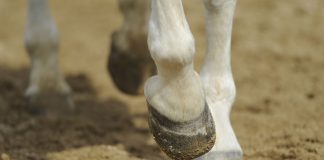


Touch is your best guide for catching early signs of issues that could become problematic if not dealt with early on.
I certainly agree with that! All kinds of bumps and lumps can be detected, some of which if left unattended, could be serious.
Thank you for the tips! I would like to add a very personal opinion too as not only is grooming for the show coat, but also the horse will reveal to the rider just what his treatment is before and after training. A sadistic groom can undermine the best efforts of even the most ardent and empathetic trainer. Good grooms, like good shoers, are a rare commodity these days in a world that seeks to commodify everything. A lot of the servants of the horse world have truly thankless jobs. Praise your groom, and give them a raise!